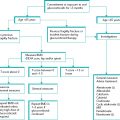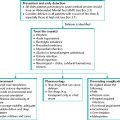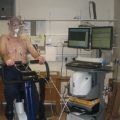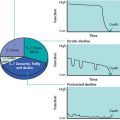Pharmacokinetics and pharmacodynamics in old age
Pharmacokinetics refers to what the body does to a drug. Pharmacodynamics refers to what a drug does to the body.
Pharmacokinetic differences
Age-related changes lead to differences in absorption, distribution, metabolism and elimination of drugs. Whilst some of these differences are not clinically significant, some are.
- There is a reduced volume of distribution for many drugs because of reduced total body water and an increase in the percentage of body weight as fat. As a result, dose requirements are less than in younger people. For example, digoxin is a water-soluble drug, and lower loading doses may be required. Diazepam is a lipid-soluble drug and the relative increase in body fat may lead to accumulation, causing toxicity.
- Liver metabolism is reduced, leading to slower drug inactivation. Reduced liver blood flow is made worse by cardiac failure, potentially leading to increased drug concentrations, although this is rarely of clinical significance. However, care should be taken when prescribing drugs that are metabolised in the liver and have a narrow therapeutic index: warfarin, theophyllines and phenytoin. Plasma levels of these drugs should be monitored.
- Perhaps the most clinically significant difference is that renal blood flow and mass reduce significantly with age, leading to a reduction in the clearance of many drugs, especially water-soluble ones. Because of less muscle mass, the creatinine can remain within the quoted normal range in older people, despite a significantly impaired glomerular filtration rate (GFR). Doses of some commonly prescribed drugs should be reduced to account for reduced renal function (as measured by GFR). Examples are ciprofloxacin, gentamicin, digoxin and lithium.
Pharmacodynamic differences
There is an increased sensitivity to drugs in general, and lower doses are often required compared to younger adults, primarily due to changes in drug receptors and impaired homeostatic mechanisms. For example, a patient started on treatment for hypertension may develop dizziness due to reduced baroreceptor sensitivity causing postural hypotension.
Adverse drug reactions
Adverse drug reactions (ADRs) are a common reason for hospital admission. Around 80% of ADRs are dose related, predictable and potentially preventable. Other ADRs may be allergic or idiosyncratic (unpredictable). However, ADRs often present in older patients non-specifically e.g. with confusion or falls.
Older people are more likely to have diseases that result in disease–drug interactions. Table 2.1 illustrates examples of diseases in old age and the disease–drug interactions that can occur with commonly prescribed medications. Every prescriber should consider these before prescribing for an older person.
There are a number of ‘problematic’ drugs in older people – prescribed medications that commonly cause side-effects. These are listed in Box 2.1.
Polypharmacy and drug–drug interactions
’Polypharmacy’ is when a patient is taking a large number of different prescribed medications, some of which may be required, and some not. There is no strict definition of polypharmacy, although the National Service Framework for Older People suggests a definition of being on four or more drugs. Some of the reasons for polypharmacy are listed in Box 2.2.
Table 2.1 Diseases in old age, and disease–drug interactions with commonly prescribed drug groups.
| Disease in older age | Drugs | Potential effect |
| Dementia | Benzodiazepines | Worsening confusion |
| Antimuscarinics, | ||
| (some) anticonvulsants | ||
| Levodopa | ||
| Parkinson’s disease | Antimuscarinics | Worsening symptoms |
| Metoclopramide | Deteriorating | |
| movement disorder | ||
| Seizure disorder/epilepsy | Antibiotics | |
| Analgesics | ||
| Antidepressants | Reduced seizure | |
| Antipsychotics | threshold/seizures | |
| Theophyllines | ||
| Alcohol | ||
| Glaucoma | Antimuscarinics | Worsening glaucoma |
| COPD/asthma | β-blockers | Bronchospasm |
| Benzodiazepines | Respiratory suppression | |
| Heart failure | Diltiazem, verapamil | Worsening heart failure |
| NSAIDs | ||
| Hypertension | NSAIDs, pseudoephedrine | Hypertension |
| Orthostatic hypotension | Antihypertensives (any) | Postural hypotension |
| Diuretics | Falls | |
| Tricyclic antidepressants | ||
| Levodopa | ||
| Cardiac conduction disorders | β-blockers, digoxin, diltiazem, | Bradycardia, |
| verapamil, amiodarone, | heart block, prolonged QTc | |
| Tricyclic antidepressants | ||
| Peripheral arterial disease | β-blockers | Intermittent claudication |
| Peptic ulcer disease | NSAIDs, anticoagulants | Upper gastrointestinal |
| haemorrhage | ||
| Hypokalaemia | Digoxin | Cardiac arrhythmia |
| Hyponatraemia | Diuretics | Worsening hyponatraemia |
| Tricyclic antidepressants | May cause or exacerbate | |
| Carbamazepine | SIADH | |
| Renal impairment | NSAIDS | Acute renal failure |
| Antibiotics | ||
| Bladder outflow obstruction/ | Antimuscarinics | Urinary retention |
| Benign prostate hyperplasia | α-blockers | |
| Urinary incontinence | α-blocker | Polyuria |
| Antimuscarinics | Worsening stress | |
| Benzodiazepines | incontinence | |









